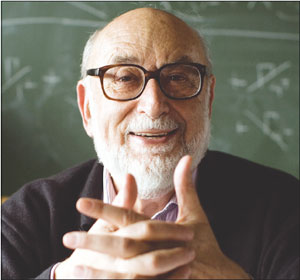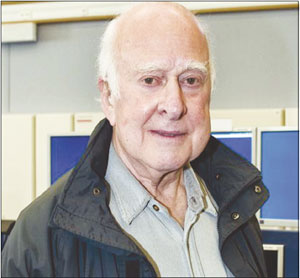There’s a famous photograph of a young Nepalese climber standing on top of Everest in 1953. It’s the only picture there is, but Tenzing Norgay was not alone. Edmund Hillary, who declined to be photographed, accompanied him to the top. Who got there first? For a while, the two climbers refused to be drawn, saying that what matters is the achievement. And so it is with a mechanism developed in the 1960s to account for the difference between long and short-range interactions in physics.

Image credit: F Englert.
In the early 1960s, particle physics had a problem. Long-range interactions, such as electromagnetism and gravity, could be explained by the theories of the day, but the short-range weak interaction, whose influence is limited to the scale of the atomic nucleus, could not. The idea that the carriers of the weak force must be heavy, while the carriers of long-range forces would be massless could account for the difference. Conceptually it made sense, but theoretically it couldn’t be done: where would the heavy carriers get their mass? There was no way to reconcile massive and massless force carriers in the same theoretical framework.
Inspired by the new theory of superconductivity put forward in the late 1950s by John Bardeen, Leon Cooper and John Schreiffer, theorist Yoichiro Nambu paved the way to a solution by postulating the idea that a broken symmetry could generate mass. In doing so he in turn inspired three young physicists in Europe to take the next step.
A modest beginning
I met one of those physicists, Peter Higgs, in autumn 2007 in his apartment on the top floor of a walk-up block in Edinburgh new town with views over a leafy square. A slice from an LHC magnet greets visitors to the apartment, where the style is 1970s chic. Copies of Physics World and Scientific American are piled high on the coffee table, topped off with a copy of the satirical paper Private Eye. Bound copies of The Gramophone line the shelves, and the living room’s prominent feature is a chair, optimally placed to make best use of the audiophile Leak hi-fi system.
A few months later, I met Robert Brout and François Englert in a spartanly furnished office, of the kind frequently occupied by professors emeriti, at the Université Libre de Bruxelles. Do we speak English or French was my first question. “Robert will be happier with English,” came the reply. I hadn’t realised that Brout was a naturalized Belgian, and that the two had first worked together in 1959 when he’d hired Englert to join him in his work at Cornell University in statistical mechanics.

Image credit: F Englert.
As is so often the way with good ideas, the concept of the generation of particle mass through symmetry breaking was developed in more than one place at around the same time, two of those places being Brussels and Edinburgh. It was a modest beginning for a scientific revolution: just two short pages published on 31 August 1964 by Brout and Englert, and little more than a page from Higgs on 15 September. But those two papers were set to influence profoundly the development of particle physics right to this day.
All three scientists are careful to attribute credit to their forerunners, Nambu most strongly. Hints of other influences come from the fact that Higgs has been known to call spontaneous symmetry breaking in particle physics the relativistic Anderson mechanism, a reference to the Nobel prize-winning physicist Philip Anderson who published on the subject in 1963; and in lectures at Imperial College London students are told about the Kibble–Higgs mechanism, in a reference to a later paper published by Gerald Guralnik, Carl Hagen and Tom Kibble.
Brout’s inspiration goes back much further, to another place that symmetry is broken spontaneously in nature with macroscopic effects. “Ferromagnetism was a puzzle in 1900,” he told me, and was solved by French physicist Pierre Weiss in 1907. Essentially, symmetry is broken by the Brout–Englert–Higgs (BEH) mechanism because the ground state of the vacuum is asymmetric, rather like the alignment of the electrons’ magnetic moments in a ferromagnetic material. In the case of the BEH mechanism, however, it’s structure in the vacuum itself that gives rise to particle masses. In the words of CERN’s Alvaro de Rújula: “The vacuum is not empty, there is a difference between vacuum and emptiness.”
The thing that fills the vacuum is a scalar field commonly known as the Higgs field. Some particles interact strongly with this field, others don’t, and it is the strength of the interaction with the field that determines the masses of certain particles. In other words, the carriers of the weak interaction, the W and Z particles, are sensitive to the structure of empty space. This is how the BEH mechanism can accommodate short and long-range interactions in a single theory. The long-awaited confirmation of the mechanism is expected in the form of excitations of the field appearing as scalar bosons (Higgs particles).
Esoteric as this may seem, there are potential astronomical implications, since what particle physicists call the Higgs field, cosmologists call the cosmological constant, or dark energy. A substance that appears to make up some 70% of the universe’s matter and energy, dark energy made itself apparent as recently as 2003 in observations of the farthest reaches of the universe.
Renormalization
Despite the emergence of the BEH mechanism, particle physics still had a problem in the mid-1960s, because the underlying theory was literally not normal. It predicted abnormal results, such as probabilities of more than 100% for given outcomes. It needed to be renormalized, and that would take the best part of a decade. Brout and Englert toyed with the idea in 1966, but a rigorous renormalization had to wait until 1971, when Gerardus ‘t Hooft, a student of Martinus Veltman at Utrecht University, published the first of a series of papers by student and supervisor that would rigorously prove the renormalizability of the theory. They were rewarded with a trip to Stockholm in 1999 to collect the Nobel Prize in Physics.

If Brout, Englert and Higgs had provided a cornerstone of the Standard Model, ‘t Hooft and Veltman gave it its foundations. From then, theoretical and experimental progress was rapid, and accompanied by a rich harvest of Nobel Prizes. In 1973, a team at CERN led by André Lagarrigue found the first evidence for heavy carriers of the weak interaction. In 1979, Sheldon Glashow, Steven Weinberg and Abdus Salam received the Nobel Prize for Physics for their work on unifying the electromagnetic and weak interactions, the theory in which the BEH mechanism plays its crucial role. Then in 1984, Carlo Rubbia and Simon van der Meer received the Nobel Prize for their decisive contributions to the programme that discovered the carriers of the weak force, the W and Z particles, at CERN in 1982–1983.
“The experimental discovery of the W and Z particles confirmed both the validity of the electroweak model,” explained François Englert “and of the BEH mechanism.” There remained, however, a missing ingredient. A machine was needed that could shake the scalar boson of the BEH mechanism out of its hiding place in the vacuum of space. That machine is the LHC. Many scientists would, and indeed have, bet on the discovery of the particle, but however elegant and enticing the work of Brout, Englert and Higgs, no-one can be sure it is right until the scalar boson has been seen. Nature might have chosen to endow particles with mass in a different way, so until the particle is found, the BEH mechanism remains no more than speculation. Whatever the case, the LHC will give us the answer.
There are many stories as to how the BEH mechanism and its associated particle came to be named after Higgs. The one Higgs told me involves a meeting that he had with fellow theorist Ben Lee at a conference in 1967, at which they discussed Higgs’s work. Then along came renormalization, making field theory fashionable, and another conference. “The conference at which my name was attached to pretty well everything connected with spontaneous symmetry breaking in particle physics was in ’72,” explained Higgs. It was a conference at which Lee delivered the summary talk.
Brout, Englert and Higgs have rarely met, but they have much in common. All came to a field, unfashionable with particle theorists at the time, from different areas of science. “Sometimes you do things in a domain in which you are not an expert and it plays a big role,” explained Englert. “We had no reason to dismiss field theory because people didn’t use it.” The three also agree on many things – their inspiration for one. “What was interesting me back in the early 1960s was the work of Nambu, who was proposing field theories of elementary particles in which symmetries were broken spontaneously in analogy to the way that it happens in a superconductor,” said Higgs. Englert said it slightly differently: “We were very impressed by the fact that Nambu transcribed superconductivity in terms of field theory,” he said. “That’s a beautiful paper.”
The three are in agreement about the results that the LHC might bring. “The most uninteresting result would be if we find nothing other than that which we’re most expecting,” said Englert. According to Higgs: “The most uninteresting result would be if they found the Higgs boson and nothing much else.” “If the Standard Model works, then we’re in trouble,” said Brout. “We’ll have to rely on human intelligence to go further,” said Englert completing the thought. And the most interesting direction for physics? Gravity, they all concur. “Any crumbs that fall off it would have major effects on the world of elementary particles,” said Brout, “in my heart, gravity is the secret to everything.”
Physicists and mountaineers have much in common. They are on the whole fiercely competitive, yet collaborative at the same time, and they can be magnanimous to an extraordinary degree. “I was delighted to discover that we are sharing the prize,” Higgs said on being informed that the European Physical Society had awarded him a prestigious prize in 1997. “I get a lot of publicity for this work, but (Brout and Englert) were clearly ahead of me.”
So who did get there first? At Everest, it turns out to have been Hillary who put his foot on the summit first. In physics Brout and Englert were first to publish, but that’s not what matters. In physics, as in mountaineering, it’s the achievement that counts.





